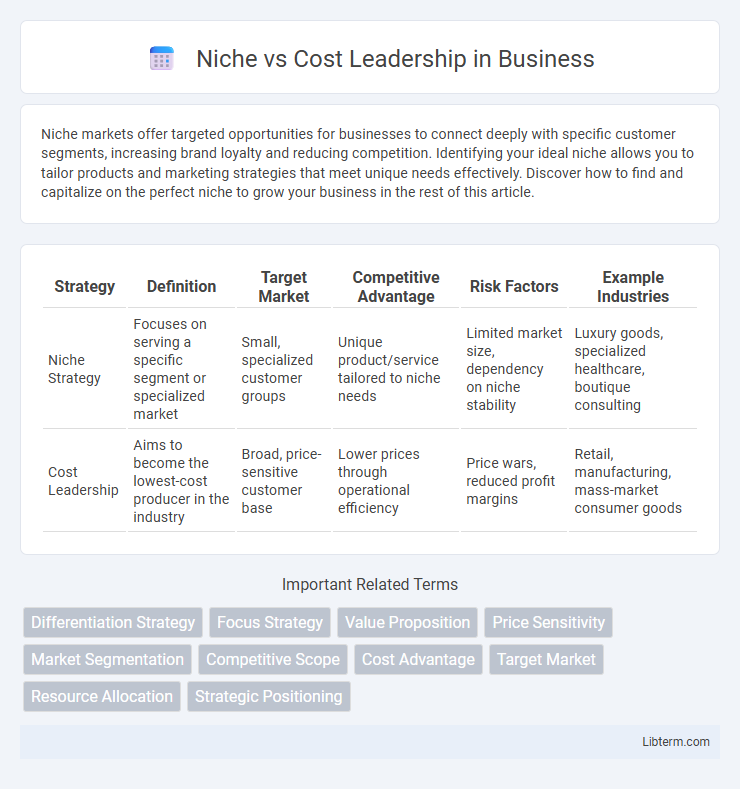Niche markets offer targeted opportunities for businesses to connect deeply with specific customer segments, increasing brand loyalty and reducing competition. Identifying your ideal niche allows you to tailor products and marketing strategies that meet unique needs effectively. Discover how to find and capitalize on the perfect niche to grow your business in the rest of this article.
Table of Comparison
| Strategy | Definition | Target Market | Competitive Advantage | Risk Factors | Example Industries |
|---|---|---|---|---|---|
| Niche Strategy | Focuses on serving a specific segment or specialized market | Small, specialized customer groups | Unique product/service tailored to niche needs | Limited market size, dependency on niche stability | Luxury goods, specialized healthcare, boutique consulting |
| Cost Leadership | Aims to become the lowest-cost producer in the industry | Broad, price-sensitive customer base | Lower prices through operational efficiency | Price wars, reduced profit margins | Retail, manufacturing, mass-market consumer goods |
Understanding Niche Strategy
Niche strategy targets a specific market segment by tailoring products or services to meet unique customer needs, enhancing competitive advantage in specialized areas. Companies adopting a niche approach leverage deep market insights and customer loyalty to achieve higher profit margins despite lower overall market share. This strategy contrasts with cost leadership by prioritizing differentiation over cost efficiency, focusing on quality, customization, and customer intimacy.
Defining Cost Leadership
Cost Leadership is a competitive strategy focused on becoming the lowest-cost producer in an industry, enabling a company to offer products or services at lower prices than competitors while maintaining profitability. This approach relies on economies of scale, efficient production processes, and tight cost controls to minimize expenses across operations. Firms employing cost leadership aim to attract price-sensitive customers, increase market share, and create barriers to entry for rivals by leveraging cost advantages.
Key Differences Between Niche and Cost Leadership
Niche leadership targets a specific market segment with specialized products or services, aiming for high customer loyalty and premium pricing, whereas cost leadership focuses on achieving the lowest production costs to offer competitive prices across a broad market. Niche strategies emphasize depth and differentiation within a narrow scope, leveraging unique expertise or features, while cost leadership relies on operational efficiency and economies of scale to dominate cost structures. Key differences include market scope, pricing approach, and value creation, with niche leadership prioritizing exclusivity and cost leadership prioritizing affordability.
Advantages of Niche Strategy
Niche strategy enables businesses to target specific market segments, allowing for specialized product offerings that meet unique customer needs and foster strong brand loyalty. This focused approach often results in reduced competition and higher profit margins due to premium pricing tailored to a distinct audience. Companies employing niche strategies benefit from enhanced customer relationships and the ability to adapt quickly to changing market demands within their chosen segment.
Benefits of Cost Leadership
Cost Leadership strategy enables businesses to achieve competitive advantage through minimizing production and operational costs, allowing for lower pricing and increased market share. This approach enhances profit margins even in highly competitive markets by leveraging economies of scale, efficient supply chain management, and cost-saving technologies. Companies adopting Cost Leadership attract price-sensitive customers, boosting sales volume and creating barriers for competitors with higher cost structures.
Market Examples of Niche vs Cost Leadership
Tesla exemplifies niche leadership by targeting premium electric vehicle consumers with advanced technology and high-performance features, differentiating itself from mass-market automakers. Walmart embodies cost leadership through its focus on low prices and operational efficiency to attract price-sensitive customers worldwide. IKEA combines cost leadership with niche elements by offering affordable, stylish, flat-pack furniture catering to cost-conscious, design-oriented consumers.
Target Audience Considerations
Niche strategies concentrate on specific market segments, tailoring products and marketing to meet the unique needs of targeted customer groups, enhancing brand loyalty and customer satisfaction. Cost leadership aims to attract a broader audience by offering competitive pricing through operational efficiency, appealing to price-sensitive consumers across various demographics. Understanding the target audience's preferences, buying behavior, and price sensitivity is crucial for selecting the appropriate strategy to maximize market share and profitability.
Risks and Challenges for Each Strategy
Niche strategies face risks such as limited market size, customer dependency, and vulnerability to changes in consumer preferences, which can lead to inconsistent revenue streams and reduced scalability. Cost leadership challenges include maintaining low operational costs without sacrificing product quality, handling price wars that erode profit margins, and investing heavily in efficient supply chains and economies of scale to sustain competitive advantage. Both strategies require continuous market analysis and adaptive measures to mitigate risks associated with competition, market shifts, and evolving customer demands.
When to Choose Niche or Cost Leadership
Businesses should choose niche strategy when targeting specialized markets with unique customer needs, allowing for premium pricing and strong brand loyalty. Cost leadership is ideal in highly competitive markets where price sensitivity dominates, requiring operational efficiency and economies of scale to maintain profitability. Analyzing industry structure, customer segments, and competitive intensity helps determine whether niche focus or cost leadership maximizes strategic advantage.
Impact on Long-Term Business Growth
Niche strategy enables long-term business growth by targeting specific market segments with tailored products, fostering strong customer loyalty and reduced competition. Cost leadership drives sustainable growth through economies of scale and operational efficiencies, allowing competitive pricing and higher profit margins. Companies combining both approaches often achieve balanced growth by capturing broad markets while maintaining specialized customer appeal.
Niche Infographic

 libterm.com
libterm.com